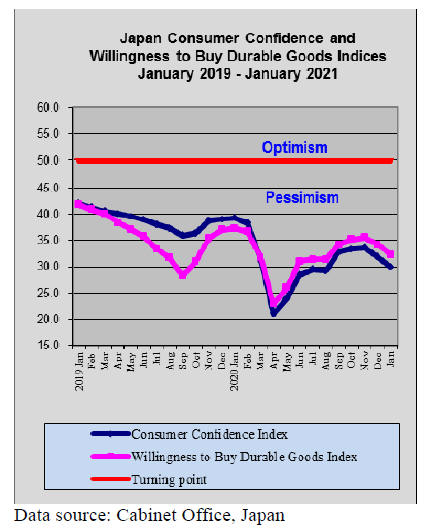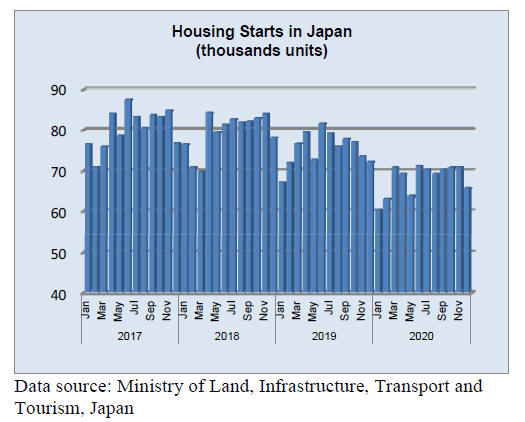Japan
Wood Products Prices
Dollar Exchange Rates of 25th
January
2021
Japan Yen 103.77
Reports From Japan
Consumer
demand takes a hit
The Japanese economy is increasingly facing challenges
following the declaration of a second state of emergency
that will be in place until 7 February. Consumer demand
has taken a hit and there are indications that prices are
falling.
The risk is that this could mark the return of deflation, a
nightmare for the government and the Bank of Japan after
years of efforts to reflate the economy.
The annual wage negotiations between management and
unions will soon begin and the early news, unsurprisingly,
is that companies are reluctant to raise pay after a difficult
2020. Without a boost to household income the prospects
for boosting consumption would weaken.
Further dip in consumer confidence
After a brief recover retail sales have declined again
driven down as the third wave of infections which resulted
in the government declaring a state of emergency in the
worst affected prefectures. The state of emergency calls
for everyone to avoid non-essential travel and gathering,
this kept shoppers home and darken the recovery outlook.
The downward trend in the January consumer confidence
index provides an indication of renewed weakness in
consumer spending, a key driver of the earlier rebound.

Yen edges firmer
The yen/dollar exchange rate continues to edge towards a
rate which will alarm the Bank of Japan (BoJ) as it tries to
steer the economy through a further tough patch brought
on by another stste of emergency due to a serious third
wave of corona infections especially impacting the main
urban areas.
At 103 plus to the US dollar the BoJ is not likely to
respond but, if as some analysts forecast, the yen
strengthens further the BoJ whas indicated it will respond.

2020 not a good year for house builders
Housing starts tumbled in December 2020 falling 9% year
on year and dropping 7% compared to the previous month.
The table below shows housing starts. 2019 was not a
good year as starts were down 5% on 2018 and the
downtrend continued in 2020 with starts dropping a
further 10%.
The impact of corona virus control measures is partly to
blame for the decline but the core of the problem for
Japanese construction companies is the aging population
and the declining birth rate.
It has been reported that 2020 was the first time since 2012
that more people have left Tokyo than flowed in. The rare
situation is said to have arisen due to the novel
coronavirus pandemic. Tokyo¡¯s population was down by
nearly 37,000 by December 2020 compared to July
marking the fifth monthly decline.
The ¡®work from home¡¯ style is eliminating the need to live
close to the workplace and people can take advantage of
lower rents in the suburbs. This has helped works adjust as
the average wage increases have satlled and
accommodation is expensive in the cities.

Furniture imports
The rising imports of wooden furniture, especially of
bedroom furniture, in the scond and third quarters of 2020
was surprising given the downward trend in consumer
confidence and especially in consumer willingness to buy
durable goods. (see consumet confidence graphic above).
While consumer confidence regained ground in the second
half of 2020 this was only a ¡®catch-up¡¯ on an earlier
decline. Clearly Japanese importers were confident of
sustained and expanding demand despite the weak
consumer confidence readings so steadily expanded
wooden furniture imports.

October office furniture imports (HS 940330)
Japan¡¯s imports of wooden office furniture have been
declining since July. Year on year there was a 12% decline
in the value of imports and month on month the decline
was around 4%.
October imports from China which accounted foralmost
70% of October arrivals were up slightly (around 4%)
compared to September but imports from the other main
suppliers dipped with shippers in Portugal seeing a7%
decline. Shipments from Poland were down 5% in October
but shipments from Italy remained at the same level as in
September.
 
October kitchen furniture imports (HS
940340)
Beginning in May there has been a steady rise in the value
of kitchen furniture imports and in October this trend
continued with an 11% rise year on year and a 23% month
on month increase.
Housing starts (see above) have been flat since mid year
suggesting the rise in kitchen furniture imports could be
driven by increased kitchen renovation as home owners
send more time at home and because of limits on outdoors
activities are focused on home improvement.
In October, shippers in the Philippines which accounted
for around half of all kitchen furniture imports into Japan
in October did well, seeing an over 30% rise in shipments.
The other top shippers in October were Vietnam which
saw an 18% rise in shipments in October and accounted
(around 40% of Japan¡¯s HS940340 imports) and China but
here the level of shipments was much the same as in
September.

October bedroom furniture imports (HS
940350)
In contrast to the upward trend in kitchen furniture imports
japan¡¯s imports of wooden bedroom furniture have been in
a narrow range since mid 2020. However, the value of
October imports was up over 30% year on year but the
month on month rise was a modest 8%.
Shippers in China accounted for around 60% of Japan¡¯s
imports of wooden bedroom furniture in October and saw
a 7% month on month increase. Vietnam is the scond
ranked shipper accounting for around 30% of October
imports (up 6% month on month). Exporters in Malaysia
and Thailand together accosted for almost 8% of October
arrivals of wooden bedroom furniture.

Trade news from the Japan Lumber Reports (JLR)
The Japan Lumber Reports (JLR), a subscription trade
journal published every two weeks in English, is
generously allowing the ITTO Tropical Timber Market
Report to reproduce news on the Japanese market
precisely as it appears in the JLR.
For the JLR report please see:
https://jfpj.jp/japan_lumber_reports/
Plywood
Demand continues active on domestic softwood plywood
in January. Normally January is quiet month but this year
is different. Delayed deliveries continue in Western Japan
and the longest is one month waiting. There are large
orders placed to the manufacturers in Eastern Japan but the
manufacturers carry excessive orders so they have no extra
volume.
Production increase is difficult due to abnormal heavy
snow fall in Northern Japan, which caused confusion of
transportation and log supply shortage. Therefore, supply
tightness would continue through end of February. The
manufacturers have been pushing the prices. The target
prices are 930 yen per sheet on 12 mm 3x6. The prices
have been inching up and there is no more 900 yen or
lower prices.
Malaysian and Indonesian plywood export prices are firm.
The largest supplier in Malaysia, Shing Yang increased the
export prices twice, one in December and another in
January.
There was expectation that the volume of imported
plywood would increase in January but the manufacturing
mills suffer log shortage and container shortage so the
supply has not increased.
The importers are not able to place large orders with high
prices when the demand in Japan stagnates so port
inventories seem to stay on tight through the first quarter.
South Sea (tropical) logs
Log production in PNG is slow but there is no reaction
since the demand is slow too. In PNG, demand by China
receded so log producers lost interest of log harvest. In
Japan, the largest tropical hardwood log plywood
manufacturer will close down in March and other mills
switched to use veneer instead of logs so there is very little
concern to log producing situation.
For more information see:
https://www.dailyadvent.com/news/c24cb997c67b1fd2254f5fde866f576e-Japan-tapers-imports-of-logs-from-tropical-trees-tonear-zero
Domestic logs and lumber
Supply of domestic logs and lumber has been tight since
last month. Demand is not large but the supply is much
tighter. Log prices have started climbing since last fall so
the production started increasing but heavy snow in
January hampers the production again.
After lumber prices rapidly started climbing in December,
sawmills are becoming bullish but foul weather reduces
production like frozen logs. Sawmills have acquired ample
logs by December so log prices are simmering down. 3
meter post cutting cedar log prices moved up to 14,000-
15,000 yen but in January, they are leveling off at 12,000-
13,000 yen. 4 meter sill cutting cypress log prices are
staying at 19,000-20,000 yen.
Lumber prices have kept going up. National average
prices
of 3 meter KD cedar post are 52,000-53,000 yen and 4
meter KD cypress sill are 62,000-64,000 yen. They are
firming. There are uneasy feelings that actual demand is
not so large but meantime there are rising demand to use
domestic wood to replace tight supplied North American
Douglas fir lumber so domestic share should increase.
|